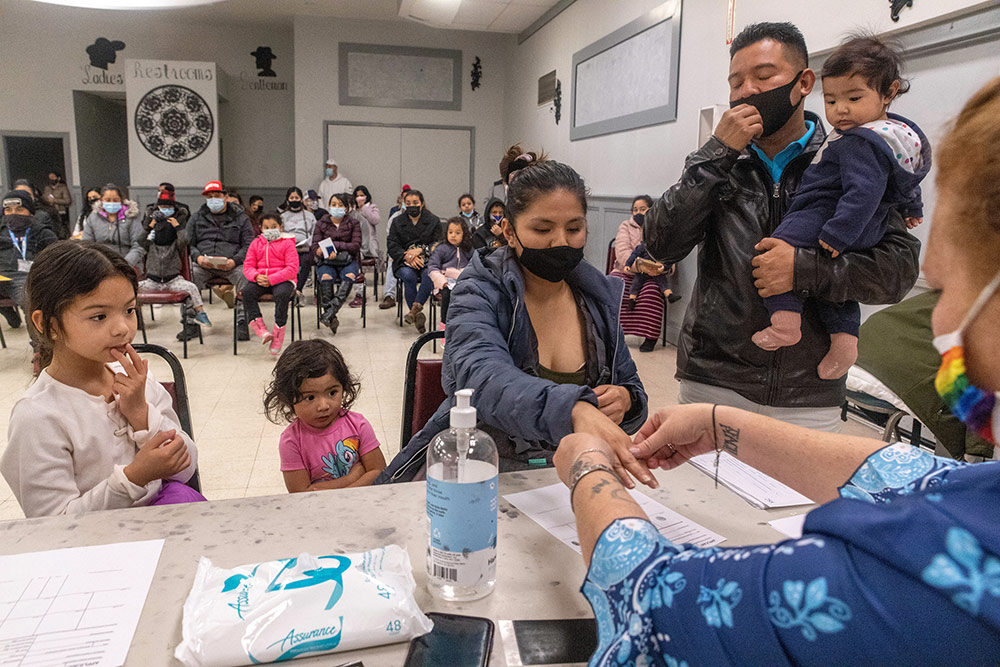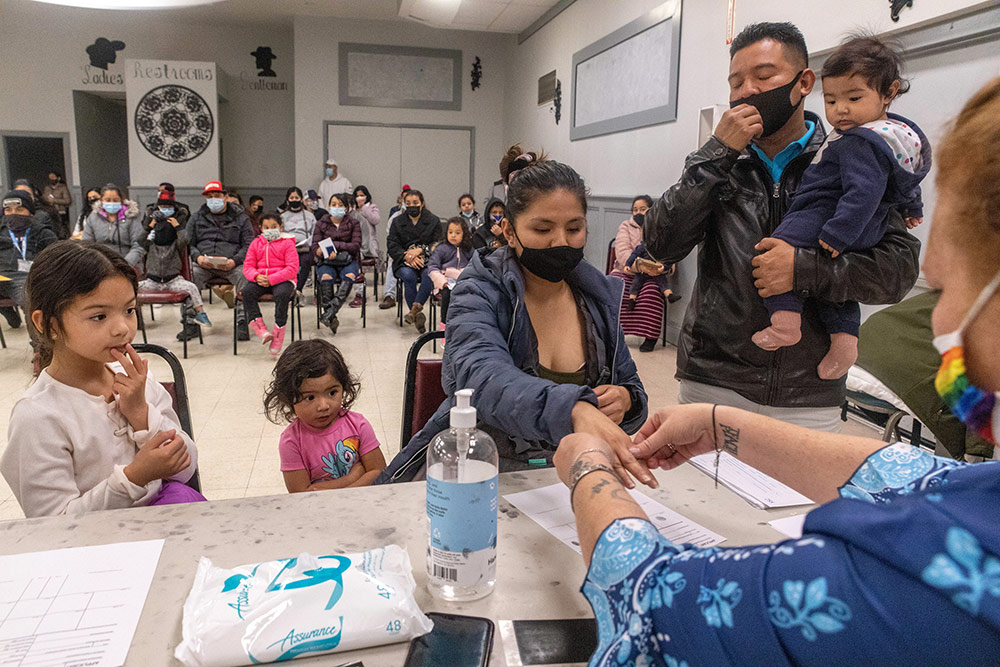治愈美国,难民将起到关键作用?

去年,美国社会基本上充斥着两大主题:分裂和生存。不管是社交距离和新冠疫情,还是美国多个城市的暴力事件,亦或是试图解读现代历史上最有争议和最令人困惑的总统大选,美国在2020年可谓是使出了浑身解数,因此有必要以团结和治愈的眼光来看待2021年。
要实现团结和治愈,最佳的方式可能莫过于审视美国的根,以及张开双臂去接纳难民。
美国总统乔·拜登曾经表示,自己打算将2021财政年的难民接纳数量上限提升至12.5万名。紧紧围绕这一目标,以及迎接那些为了远离迫害、极度渴望在美国寻找安全和自由的难民,有助于美国再次走向团结。
好客一词在柏拉图、荷马时代的希腊语以及基督教新约中被称为“philoxenia”,其字面意思就是对陌生人的爱。数个世纪以来,这个词一直都是美国的象征之一。迎接每个人回归联合政治的第一个要素就是重申自由女神像基座上所镌刻的爱玛·拉扎露丝的十四行诗所体现的价值,即让自己成为希望之塔,为那些在其他世界“渴望得到自由”的人指明方向。虽然将难民上限调整为12.5万并未创下历史新高,而且过去的几届政府曾经接纳了更多难民来到我们的国度,但拜登政府预期的12.5万难民目标相对于最近财政年度涌入美国的11,814名难民来说将是一个巨大的增幅。
更重要的是,此举将通过重启我们接纳难民的历史传统,让我们的国家再次走向团结。朝着12.5万名难民的目标努力是汇聚民心、让美国再次关注自身崇高理想之精髓的绝佳方式。这个挑战旨在重振我们这个疲乏的民族,但它需要所有民众的努力和投入。
实现这个目标水平的难民安置将为美国人提供主动合作的机会。为了实现这个目标,我们需要在公共和私营领域进行宣传。为难民在美国找一个新家取决于联邦政府、非营利机构和当地社区的合作。包括世援社(World Relief)在内的9家全国性难民接纳和安置机构将需要时间来重构在过去四年中逐渐被废除的网络和基础设施。
与难民吸纳数量一样,难民安置机构也出现了相应的萎缩。在2016-2020财政年度,世援社发现难民安置数量下滑了85%。受累于资金的减少以及难民入境数量的突然下滑所导致的员工数量过剩,世援社在四年内关闭了8个美国分支机构。其他机构也做出了类似困难的抉择。当前,安置机构的数量较2017年初减少了38%。
这类基础设施基本上无法在一夜之间完成重建。然而,这也为我们的国家带来了机会。
美国民众在难民安置方面有诸多历史先例。在美国甚至还未迈入20世纪之前,我们欢迎了“四八年难民”(19世纪在其祖国因为反对立宪政府而受到威胁的德国政治难民);在20世纪10年代的墨西哥革命期间,美国接收了数万名因为战争恐惧而背井离乡的墨西哥难民。就在最近的战后时期,美国接纳了为逃避二战和铁幕统治而流离失所的38万名欧洲难民。美国的历史拼图上一直都有新的板块出现。
这一规律已经延续至当代时期。自古巴民众开始受到卡斯特罗政权迫害以来,美国已经接纳了150万古巴难民。最近,超过8万名不丹洛沙姆帕族为了逃离本国的种族清洗而寻求避难,并在美国重新安家。这些难民以及其他众多难民都决定成为美国这块拼图的一部分。如果难民安置计划得以恢复,那么这一态势就有可能得到加强。
那么,我们如何利用这个机会来实现自我治愈?
首先,所有民众,不管是个人还是在慈善、宗教或公益机构工作的人士,应该专注于了解这些难民的身份以及美国难民安置的工作流程,并抛弃普遍存在的错误观念,倾听难民自身令人信服的故事。
第二,美国民众应该继续为难民安置奔走相告。重要的一点在于,美国民众应该让拜登对自己有关难民安置的承诺负责。我们还可以敦促国会代表来支持和重启美国难民安置计划,因为他们在决定难民接纳上限以及拨款方面发挥着强大的咨询引导作用。
第三,美国民众应该联络其所在地区的难民安置机构,并询问自己能够提供哪些帮助?所有这些机构都计划扩张或重建基础设施和能力,以应对难民接纳数量的大幅上升,因此,它们将需要资金方面的合作、志愿者以及实物捐赠,从而为新抵达的难民提供家居用品。个人和会众都可以参与组织此类活动。
我希望美国民众,无论其所处政党阵营,都能够挺身而出,帮助重启美国难民安置计划。(财富中文网)
詹妮弗·弗依是世援社美国分会的副会长。该组织是与美国国务院开展难民安置合作的9个全国性组织之一。
译者:冯丰
审校:夏林

去年,美国社会基本上充斥着两大主题:分裂和生存。不管是社交距离和新冠疫情,还是美国多个城市的暴力事件,亦或是试图解读现代历史上最有争议和最令人困惑的总统大选,美国在2020年可谓是使出了浑身解数,因此有必要以团结和治愈的眼光来看待2021年。
要实现团结和治愈,最佳的方式可能莫过于审视美国的根,以及张开双臂去接纳难民。
美国总统乔·拜登曾经表示,自己打算将2021财政年的难民接纳数量上限提升至12.5万名。紧紧围绕这一目标,以及迎接那些为了远离迫害、极度渴望在美国寻找安全和自由的难民,有助于美国再次走向团结。
好客一词在柏拉图、荷马时代的希腊语以及基督教新约中被称为“philoxenia”,其字面意思就是对陌生人的爱。数个世纪以来,这个词一直都是美国的象征之一。迎接每个人回归联合政治的第一个要素就是重申自由女神像基座上所镌刻的爱玛·拉扎露丝的十四行诗所体现的价值,即让自己成为希望之塔,为那些在其他世界“渴望得到自由”的人指明方向。虽然将难民上限调整为12.5万并未创下历史新高,而且过去的几届政府曾经接纳了更多难民来到我们的国度,但拜登政府预期的12.5万难民目标相对于最近财政年度涌入美国的11,814名难民来说将是一个巨大的增幅。
更重要的是,此举将通过重启我们接纳难民的历史传统,让我们的国家再次走向团结。朝着12.5万名难民的目标努力是汇聚民心、让美国再次关注自身崇高理想之精髓的绝佳方式。这个挑战旨在重振我们这个疲乏的民族,但它需要所有民众的努力和投入。
实现这个目标水平的难民安置将为美国人提供主动合作的机会。为了实现这个目标,我们需要在公共和私营领域进行宣传。为难民在美国找一个新家取决于联邦政府、非营利机构和当地社区的合作。包括世援社(World Relief)在内的9家全国性难民接纳和安置机构将需要时间来重构在过去四年中逐渐被废除的网络和基础设施。
与难民吸纳数量一样,难民安置机构也出现了相应的萎缩。在2016-2020财政年度,世援社发现难民安置数量下滑了85%。受累于资金的减少以及难民入境数量的突然下滑所导致的员工数量过剩,世援社在四年内关闭了8个美国分支机构。其他机构也做出了类似困难的抉择。当前,安置机构的数量较2017年初减少了38%。
这类基础设施基本上无法在一夜之间完成重建。然而,这也为我们的国家带来了机会。
美国民众在难民安置方面有诸多历史先例。在美国甚至还未迈入20世纪之前,我们欢迎了“四八年难民”(19世纪在其祖国因为反对立宪政府而受到威胁的德国政治难民);在20世纪10年代的墨西哥革命期间,美国接收了数万名因为战争恐惧而背井离乡的墨西哥难民。就在最近的战后时期,美国接纳了为逃避二战和铁幕统治而流离失所的38万名欧洲难民。美国的历史拼图上一直都有新的板块出现。
这一规律已经延续至当代时期。自古巴民众开始受到卡斯特罗政权迫害以来,美国已经接纳了150万古巴难民。最近,超过8万名不丹洛沙姆帕族为了逃离本国的种族清洗而寻求避难,并在美国重新安家。这些难民以及其他众多难民都决定成为美国这块拼图的一部分。如果难民安置计划得以恢复,那么这一态势就有可能得到加强。
那么,我们如何利用这个机会来实现自我治愈?
首先,所有民众,不管是个人还是在慈善、宗教或公益机构工作的人士,应该专注于了解这些难民的身份以及美国难民安置的工作流程,并抛弃普遍存在的错误观念,倾听难民自身令人信服的故事。
第二,美国民众应该继续为难民安置奔走相告。重要的一点在于,美国民众应该让拜登对自己有关难民安置的承诺负责。我们还可以敦促国会代表来支持和重启美国难民安置计划,因为他们在决定难民接纳上限以及拨款方面发挥着强大的咨询引导作用。
第三,美国民众应该联络其所在地区的难民安置机构,并询问自己能够提供哪些帮助?所有这些机构都计划扩张或重建基础设施和能力,以应对难民接纳数量的大幅上升,因此,它们将需要资金方面的合作、志愿者以及实物捐赠,从而为新抵达的难民提供家居用品。个人和会众都可以参与组织此类活动。
我希望美国民众,无论其所处政党阵营,都能够挺身而出,帮助重启美国难民安置计划。(财富中文网)
詹妮弗·弗依是世援社美国分会的副会长。该组织是与美国国务院开展难民安置合作的9个全国性组织之一。
译者:冯丰
审校:夏林
Last year was largely characterized by separation and survival. Whether it was social distancing and COVID-19, violence in America’s cities, or attempting to sort out one of the most contentious and confusing elections in modern memory, America struggled in 2020, and needs to view 2021 with an eye toward unity and healing.
Perhaps the best way to do that is to unify and heal by returning to our American roots, and welcoming refugees into our country.
President-elect Joe Biden has stated his intention to raise the ceiling for refugee admissions to 125,000 for fiscal year 2021. Unifying around this goal, and welcoming those who have fled persecution and are desperate to find safety and freedom in America, could help the U.S. to again find unity.
Hospitality—which in the Greek language of Plato, Homer, and the Christian New Testament is philoxenia, literally the love of strangers—has been a feature of America at our best throughout the centuries. The first key to welcoming each other back into a coherent body politic is reclaiming the values espoused by Emma Lazarus’s sonnet engraved on the base of the Statue of Liberty, committing ourselves to being a beacon of hope for those from other parts of the world “yearning to breathe free.” Setting the refugee ceiling at 125,000 is not historically high—past administrations have had invited more refugees to our nation—but the Biden administration’s projected 125,000 goal would be a huge increase over the 11,814 refugees brought to America over the most recent fiscal year.
More importantly, this move would be a big step toward reunifying our nation by reinvigorating our historical practice of welcoming refugees. Aiming for that 125,000 goal is the perfect way to come together and recommit our nation to the best of our national ideals. This will be a challenge that revives a tired nation, but it will take work and commitment from all of our citizens.
Achieving that target level for refugee resettlement is a chance for Americans to take the initiative in working together. To do this, we’ll need to advocate on both public and private fronts. Finding a new home for refugees in America is a matter of cooperation between the federal government, nonprofit organizations, and local communities. The nine national agencies that welcome and resettle refugees, including World Relief, will require time to rebuild the networks and infrastructure that has slowly been dismantled over the last four years.
Organizations that resettle refugees have shrunk ommensurately with refugee intake. Between fiscal years 2016 and 2020, World Relief saw an 85% decline in refugees resettled. World Relief has closed eight U.S. locations in four years, thanks to less funding and a mismatch between staff and suddenly reduced refugee arrival numbers. Other agencies have made similarly difficult decisions. There are currently 38% fewer resettlement offices than at the beginning of 2017.
That infrastructure simply cannot be rebuilt overnight. But therein lies the opportunity for our country.
Americans have many historical precedents in refugee resettlement. Before America even entered the 20th century, we were welcoming the Forty-Eighters, 19th-century German political refugees who were threatened in their homelands for fighting for constitutional government. In the Mexican Revolution of the 1910s, thousands of Mexican refugees fleeing the horrors of war were welcomed into the U.S. As recently as the post-war era, America opened her arms to 380,000 displaced Europeans fleeing the ravages of World War II and the Iron Curtain. The fabric of our history is constantly adding new threads.
That pattern has continued into the modern era. Since the Castro regime began oppressing the Cuban people, the U.S. has welcomed 1.5 million Cuban refugees to our shores. More recently, more than 80,000 Bhutanese Lhotshampas have resettled in the U.S., seeking refuge from ethnic cleansing in their homeland. These and many others have made the decision to become part of the tapestry that is America—and that dynamic is likely to increase if the refugee resettlement program is restored.
So how do we use this as an opportunity to heal?
First, people—both individually and in charitable, religious, or civic-minded organizations—should focus on learning about who refugees are and how the U.S. refugee resettlement process works, abandoning common misconceptions, and listening to the compelling stories of refugees themselves.
Second, Americans should continue to advocate for refugee resettlement. It’s vital that Americans hold Biden accountable forto his dedication commitment to refugee resettlement. We can also invoke urge our congressional representatives, who have an influential consultative role in determining setting the refugee ceiling and passing appropriations, to support the restoration of the U.S. refugee resettlement program.
Third, Americans should reach out to the refugee resettlement agencies in their region and ask how they can help. All of these organizations are planning trying to expand rebuild infrastructure and capacity for a significantdramatic increase in refugee admissions, and they will need financial partnership, volunteers, and in-kind donations to furnish homes for newly- arriving refugees. Individuals and congregations can be a part of organizing such efforts.
My hope is that Americans, regardless of political party, will step up to help restore the U.S. refugee resettlement program.
Jennifer Foy is the vice president of U.S. Programs for World Relief, one of nine national agencies that partner with the U.S. State Department to resettle refugees.













